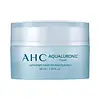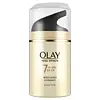What's inside
What's inside
 Key Ingredients
Key Ingredients

 Benefits
Benefits

 Concerns
Concerns

 Ingredients Side-by-side
Ingredients Side-by-side

Water
Skin ConditioningPropanediol
SolventButylene Glycol
HumectantGlycerin
HumectantCeramide AP
Skin Conditioning1,2-Hexanediol
Skin ConditioningNiacinamide
SmoothingPolymethylsilsesquioxane
Cyclopentasiloxane
EmollientDimethicone
EmollientCyclohexasiloxane
EmollientEthylhexyl Palmitate
EmollientCodium Tomentosum Extract
Skin ProtectingEnteromorpha Compressa Extract
Skin ProtectingUndaria Pinnatifida Extract
Skin ConditioningAmmonium Acryloyldimethyltaurate/Vp Copolymer
Carbomer
Emulsion StabilisingCetearyl Olivate
Cetyl Ethylhexanoate
EmollientTromethamine
BufferingSorbitan Olivate
EmulsifyingArtemisia Princeps Leaf Extract
Skin ConditioningPolyglyceryl-10 Oleate
Skin ConditioningParfum
MaskingSea Water
HumectantEthylhexylglycerin
Skin ConditioningAdenosine
Skin ConditioningHydrogenated Lecithin
EmulsifyingDisodium EDTA
Sodium Hyaluronate
HumectantCaprylic/Capric Triglyceride
MaskingCamellia Sinensis Leaf Extract
AntimicrobialNelumbo Nucifera Flower Extract
Skin ConditioningPropylene Glycol
HumectantButyrospermum Parkii Butter
Skin ConditioningAvena Sativa Kernel Extract
AbrasiveLilium Candidum Bulb Extract
Skin ConditioningCeramide NP
Skin ConditioningMyrothamnus Flabellifolia Leaf/Stem Extract
HumectantCeramide Ns
Skin ConditioningCholesterol
EmollientCeramide As
Skin ConditioningEucalyptus Globulus Leaf Extract
PerfumingMadecassic Acid
Skin ConditioningAsiaticoside
AntioxidantAsiatic Acid
Skin ConditioningAscorbic Acid
AntioxidantCitric Acid
BufferingPhytosphingosine
Skin ConditioningCeramide EOP
Skin ConditioningWater, Propanediol, Butylene Glycol, Glycerin, Ceramide AP, 1,2-Hexanediol, Niacinamide, Polymethylsilsesquioxane, Cyclopentasiloxane, Dimethicone, Cyclohexasiloxane, Ethylhexyl Palmitate, Codium Tomentosum Extract, Enteromorpha Compressa Extract, Undaria Pinnatifida Extract, Ammonium Acryloyldimethyltaurate/Vp Copolymer, Carbomer, Cetearyl Olivate, Cetyl Ethylhexanoate, Tromethamine, Sorbitan Olivate, Artemisia Princeps Leaf Extract, Polyglyceryl-10 Oleate, Parfum, Sea Water, Ethylhexylglycerin, Adenosine, Hydrogenated Lecithin, Disodium EDTA, Sodium Hyaluronate, Caprylic/Capric Triglyceride, Camellia Sinensis Leaf Extract, Nelumbo Nucifera Flower Extract, Propylene Glycol, Butyrospermum Parkii Butter, Avena Sativa Kernel Extract, Lilium Candidum Bulb Extract, Ceramide NP, Myrothamnus Flabellifolia Leaf/Stem Extract, Ceramide Ns, Cholesterol, Ceramide As, Eucalyptus Globulus Leaf Extract, Madecassic Acid, Asiaticoside, Asiatic Acid, Ascorbic Acid, Citric Acid, Phytosphingosine, Ceramide EOP
Water
Skin ConditioningGlycerin
HumectantNiacinamide
SmoothingIsohexadecane
EmollientDimethicone
EmollientIsopropyl Isostearate
EmollientStearyl Alcohol
EmollientPanthenol
Skin ConditioningTocopheryl Acetate
AntioxidantSodium Ascorbyl Phosphate
AntioxidantRetinyl Propionate
Skin ConditioningCamellia Sinensis Leaf Extract
AntimicrobialBHT
AntioxidantC13-14 Isoparaffin
EmollientCaprylyl Glycol
EmollientDimethiconol
EmollientLaureth-7
EmulsifyingCetearyl Glucoside
EmulsifyingCetearyl Alcohol
EmollientStearic Acid
CleansingPalmitic Acid
EmollientCetyl Alcohol
EmollientBehenyl Alcohol
EmollientDisodium EDTA
Polyacrylamide
PEG-100 Stearate
Titanium Dioxide
Cosmetic Colorant1,2-Hexanediol
Skin ConditioningPhenoxyethanol
PreservativeParfum
MaskingCI 19140
Cosmetic ColorantCI 16035
Cosmetic ColorantWater, Glycerin, Niacinamide, Isohexadecane, Dimethicone, Isopropyl Isostearate, Stearyl Alcohol, Panthenol, Tocopheryl Acetate, Sodium Ascorbyl Phosphate, Retinyl Propionate, Camellia Sinensis Leaf Extract, BHT, C13-14 Isoparaffin, Caprylyl Glycol, Dimethiconol, Laureth-7, Cetearyl Glucoside, Cetearyl Alcohol, Stearic Acid, Palmitic Acid, Cetyl Alcohol, Behenyl Alcohol, Disodium EDTA, Polyacrylamide, PEG-100 Stearate, Titanium Dioxide, 1,2-Hexanediol, Phenoxyethanol, Parfum, CI 19140, CI 16035
Ingredients Explained
These ingredients are found in both products.
Ingredients higher up in an ingredient list are typically present in a larger amount.
1,2-Hexanediol is a synthetic liquid and another multi-functional powerhouse.
It is a:
- Humectant, drawing moisture into the skin
- Emollient, helping to soften skin
- Solvent, dispersing and stabilizing formulas
- Preservative booster, enhancing the antimicrobial activity of other preservatives
Camellia Sinensis Leaf Extract is derived from the leaves of the tea plant. Black tea, green tea, and oolong tea are all harvested from this plant.
This ingredient has many skin benefits:
This ingredient contains polyphenols, a strong antioxidant. Antioxidants help fight off molecules that damage skin cells.
On top of that, the antioxidants in green tea neutralize free-radicals from the sun. This gives the skin some extra UV protection, but should not replace sunscreen.
Many components of tea have anti-inflammatory properties.
Polyphenols and L-theanine help soothe the skin and reduce irritation. The caffeine in Camellia Sinensis Leaf Extract helps calm inflamed blood vessels.
Other compounds found in tea include: Vitamin Bs, linoleic acid, magnesium, calcium, iron, and zinc.
Research has shown both drinking Camellia Sinensis Leaf Tea and applying it to the skin can help boost skin elasticity and hydration. Studies also show using tea extract may reduce sebum, or oil, production.
Learn more about Camellia Sinensis Leaf ExtractDimethicone is a type of synthetic silicone created from natural materials such as quartz.
What it does:
Dimethicone comes in different viscosities:
Depending on the viscosity, dimethicone has different properties.
Ingredients lists don't always show which type is used, so we recommend reaching out to the brand if you have questions about the viscosity.
This ingredient is unlikely to cause irritation because it does not get absorbed into skin. However, people with silicone allergies should be careful about using this ingredient.
Note: Dimethicone may contribute to pilling. This is because it is not oil or water soluble, so pilling may occur when layered with products. When mixed with heavy oils in a formula, the outcome is also quite greasy.
Learn more about DimethiconeDisodium EDTA plays a role in making products more stable by aiding other preservatives.
It is a chelating agent, meaning it neutralizes metal ions that may be found in a product.
Disodium EDTA is a salt of edetic acid and is found to be safe in cosmetic ingredients.
Learn more about Disodium EDTAGlycerin is already naturally found in your skin. It helps moisturize and protect your skin.
A study from 2016 found glycerin to be more effective as a humectant than AHAs and hyaluronic acid.
As a humectant, it helps the skin stay hydrated by pulling moisture to your skin. The low molecular weight of glycerin allows it to pull moisture into the deeper layers of your skin.
Hydrated skin improves your skin barrier; Your skin barrier helps protect against irritants and bacteria.
Glycerin has also been found to have antimicrobial and antiviral properties. Due to these properties, glycerin is often used in wound and burn treatments.
In cosmetics, glycerin is usually derived from plants such as soybean or palm. However, it can also be sourced from animals, such as tallow or animal fat.
This ingredient is organic, colorless, odorless, and non-toxic.
Glycerin is the name for this ingredient in American English. British English uses Glycerol/Glycerine.
Learn more about GlycerinNiacinamide is a multitasking form of vitamin B3 that strengthens the skin barrier, reduces pores and dark spots, regulates oil, and improves signs of aging.
And the best part? It's gentle and well-tolerated by most skin types, including sensitive and reactive skin.
You might have heard of "niacin flush", or the reddening of skin that causes itchiness. Niacinamide has not been found to cause this.
In very rare cases, some individuals may not be able to tolerate niacinamide at all or experience an allergic reaction to it.
If you are experiencing flaking, irritation, and dryness with this ingredient, be sure to double check all your products as this ingredient can be found in all categories of skincare.
When incorporating niacinamide into your routine, look out for concentration amounts. Typically, 5% niacinamide provides benefits such as fading dark spots. However, if you have sensitive skin, it is better to begin with a smaller concentration.
When you apply niacinamide to your skin, your body converts it into nicotinamide adenine dinucleotide (NAD). NAD is an essential coenzyme that is already found in your cells as "fuel" and powers countless biological processes.
In your skin, NAD helps repair cell damage, produce new healthy cells, support collagen production, strengthen the skin barrier, and fight environmental stressors (like UV and pollution).
Our natural NAD levels start to decline with age, leading to slower skin repair, visible aging, and a weaker skin barrier. By providing your skin niacinamide, you're recharging your skin's NAD levels. This leads to stronger, healthier, and younger looking skin.
Another name for vitamin B3 is nicotinamide. This vitamin is water-soluble and our bodies don't store it. We obtain Vitamin B3 from either food or skincare. Meat, fish, wheat, yeast, and leafy greens contain vitamin B3.
The type of niacinamide used in skincare is synthetically created.
Learn more about NiacinamideParfum is a catch-all term for an ingredient or more that is used to give a scent to products.
Also called "fragrance", this ingredient can be a blend of hundreds of chemicals or plant oils. This means every product with "fragrance" or "parfum" in the ingredients list is a different mixture.
For instance, Habanolide is a proprietary trade name for a specific aroma chemical. When used as a fragrance ingredient in cosmetics, most aroma chemicals fall under the broad labeling category of “FRAGRANCE” or “PARFUM” according to EU and US regulations.
The term 'parfum' or 'fragrance' is not regulated in many countries. In many cases, it is up to the brand to define this term.
For instance, many brands choose to label themselves as "fragrance-free" because they are not using synthetic fragrances. However, their products may still contain ingredients such as essential oils that are considered a fragrance by INCI standards.
One example is Calendula flower extract. Calendula is an essential oil that still imparts a scent or 'fragrance'.
Depending on the blend, the ingredients in the mixture can cause allergies and sensitivities on the skin. Some ingredients that are known EU allergens include linalool and citronellol.
Parfum can also be used to mask or cover an unpleasant scent.
The bottom line is: not all fragrances/parfum/ingredients are created equally. If you are worried about fragrances, we recommend taking a closer look at an ingredient. And of course, we always recommend speaking with a professional.
Learn more about ParfumWater. It's the most common cosmetic ingredient of all. You'll usually see it at the top of ingredient lists, meaning that it makes up the largest part of the product.
So why is it so popular? Water most often acts as a solvent - this means that it helps dissolve other ingredients into the formulation.
You'll also recognize water as that liquid we all need to stay alive. If you see this, drink a glass of water. Stay hydrated!
Learn more about Water